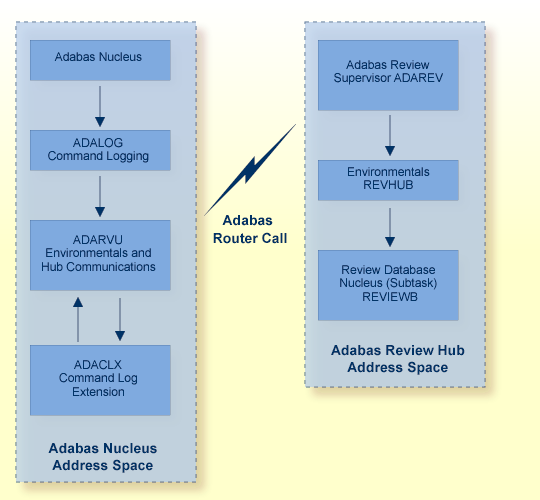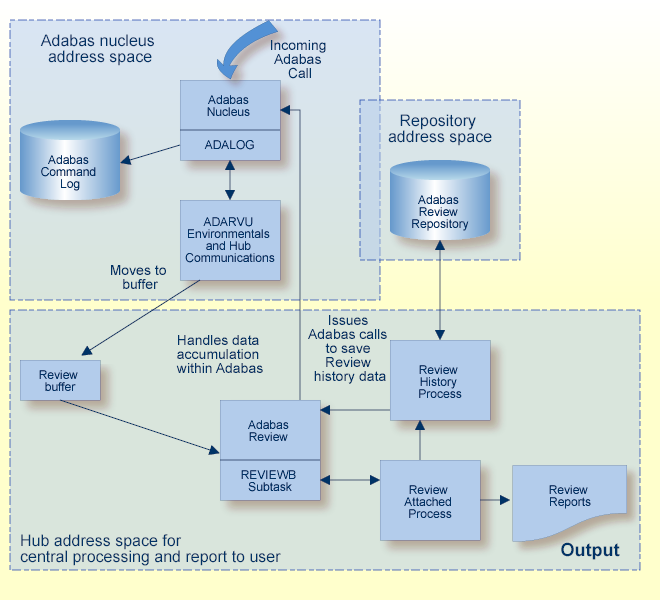In hub mode, Adabas Review uses a client/server approach to collecting data:
an interface (the client) resides on each Adabas nucleus; and
the hub (the server) resides in its own address space, partition, or region.
The interface uses the existing Adabas interregion communication process: ADALNK, ADASVC, and ADAMPM. This process is consistent across the targeted platforms for Adabas Review. If systems are networked correctly, hub mode supports a multiple platform, multiple operating system, Adabas database environment.
This document covers the following topics:
The Adabas Review hub is a centralized data collector and reporting interface that combines proven components of Adabas and Adabas Review.
It handles the data consolidation and reporting functions for monitoring an Adabas database, including usage information related to applications, commands, minimum command response time (CMDRESP), I/O activity, and buffer efficiency.
The interactive reporting facility allows you to pinpoint problems quickly, providing detailed and summary data about Adabas activities. Specific information about each database is also available.
The centralized collection server has several advantages:
A single hub collects information from multiple Adabas nuclei, Adabas Parallel Services (support for single operating system image multiprocessing) clusters, or Adabas Cluster Services (support for IBM's parallel sysplex environment) clusters.
Because a single hub can support multiple Adabas nuclei, the number of Adabas Review nuclei required to support an enterprise-wide distribution of Adabas nuclei is reduced. This minimizes resource requirements and increases performance.
Isolating the Review subtask from the Adabas nucleus enhances the performance of the Adabas main task and minimizes the impact of future Adabas releases on the functioning of Adabas Review.
ADAREV, a logic module that manages and supervises the incoming Review data calls and requests;
REVHUB, a module to establish and maintain the environmentals for Adabas Review;
the Review DB nucleus and subsystems including RAOSAUTO, the autostarted report parameter generation routine, and RAOSHIST, the historical data population routine.
The Adabas Review interface constructs and then transmits the Review data from the Adabas nucleus to the Adabas Review hub. An Adabas Review interface is integrated with each Adabas nucleus that is monitored.
ADACLX, the Adabas command log extension module that is responsible for acquiring additional information not present in the Adabas command log record; and
ADARVU, which handles the environment conditions for ADACLX and the Adabas API requirements for transmitting the Review data to the Adabas Review hub.
To maximize performance, the ADARVU module issues an "optimistic" call from an Adabas nucleus to the Adabas Review hub without waiting for a completion or "post" from the hub; ADARVU assumes that the Review data was successfully passed to the hub.
However, ADARVU does perform an initialization step to ensure that the hub is active prior to any command processing by the Adabas nucleus. If the hub is not active, ADARVU informs you using WTOs and/or a user exit. If a user exit is used, you are given the option to wait for the hub to be activated, or continue initialization and call the hub only when it is active.
On the hub side of the call, the elimination of the cross-memory "post" call enhances performance by reducing the overhead of active communication with the Adabas clients. This allows the hub to remain a passive data collector.
The following graphic shows the major components of the Adabas Review interface (Adabas nucleus address space) and hub (Adabas Review hub address space) in a client/server architecture .

The data collection process is partly accomplished by the hub (server) component REVIEWB, the Adabas Review command log processing routine.
Note:
Adabas Review supports only command log record layout format 5
(CLOGLAYOUT=5).
REVIEWB has two modes of execution: interactive and batch.
In interactive mode, it runs as an Adabas Review subtask; that is, a unit of work that the operating system treats as separately detachable.
In batch mode, it runs as a batch job that processes sequential Adabas command log datasets.
At initialization, REVIEWB reads any autostarted report definitions the user has defined and collects data according to the reports' criteria. REVIEWB also processes requests to start, view, and purge reports from the Adabas Review online system.
In interactive mode, Adabas responds to requests and calls the
interface module
ADARVU from
ADALOG (the Adabas command logging module) if
REVIEW=hubid is specified in the
Adabas initialization parameters. Adabas passes to ADARVU information about
resource usage for each command processed by the Adabas nucleus.
Adabas Review link routine exits are used to pass TP system and Natural information from the user's address space (origin of the Adabas call) to the Adabas address space and, using an extension of the Adabas user buffer, on to ADARVU.
ADARVU queues Adabas command log records received from ADALOG to REVIEWB through an intermediate REVIEW-BUFFER in the hub (server) address space. REVIEWB processes the records, accumulating and tabulating various data according to the criteria specified in any user-defined reports that are active.
The resulting nucleus statistics may be
displayed in an online environment from the Adabas Review user interface;
saved automatically in an Adabas file called the Adabas Review repository;
printed automatically when the Adabas nucleus terminates; or
downloaded directly to a personal computer (PC) using Software AG's Entire Connection.
As a batch job, Adabas Review processes Adabas command log records from a sequential dataset. If you use Adabas dual command logging, you must first use the Adabas utility function ADARES CLCOPY to generate a sequential command log dataset suitable for input into Adabas Review.
When Adabas Review executes as a batch job, input report parameters that define the data collection criteria selected by the user are read from statements in the RVUPARM dataset or the RVUAUT1/RVUAUT2 datasets. These statements can be generated using the GENCARD statement.
The storage allocated for reports is exactly the same as that for Adabas Review executing in interactive (online) mode. However, since REVIEWB is reading the command log records directly from a sequential file, no REVIEW-BUFFER is allocated.
The following graphic shows the Adabas Review data collection process for hub mode. When monitoring multiple databases, Adabas Review allows you to switch from one database to another and provide reports for each.
